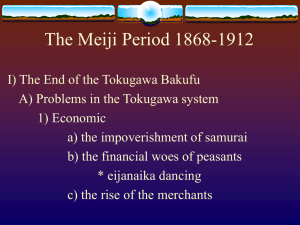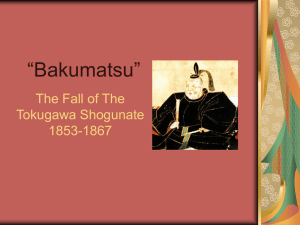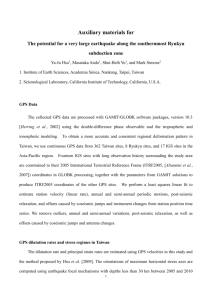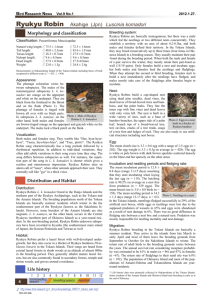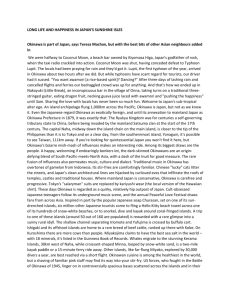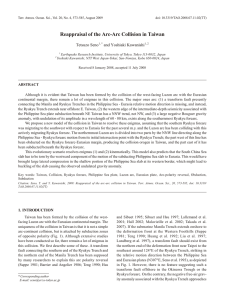琉球王国 The Ryukyu Kingdom/Empire の 国際交易
advertisement
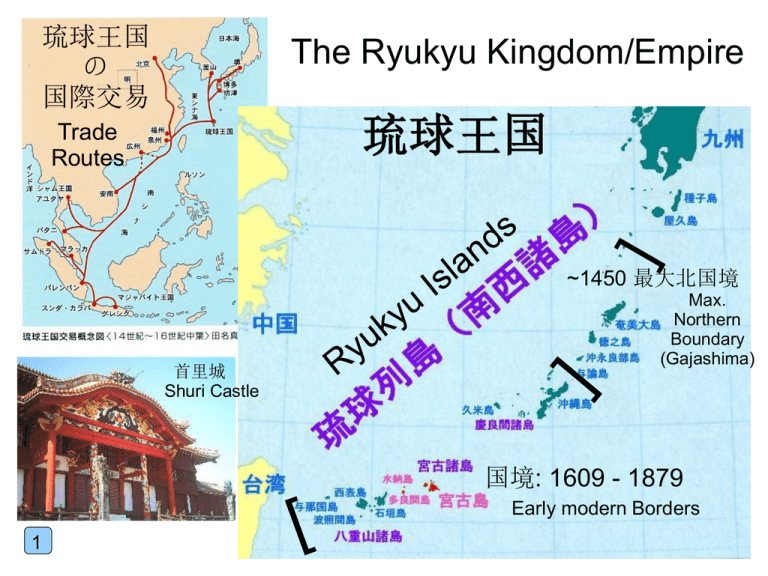
琉球王国 の 国際交易 The Ryukyu Kingdom/Empire 琉球王国 Trade Routes ~1450 最大北国境 首里城 Shuri Castle Max. Northern Boundary (Gajashima) 国境: 1609 - 1879 Early modern Borders 1 沖縄 「境」というのは、さまざまな種 類がある。 京都(例外)国境を超える「文化 圏」はその一つ。「石敢 当文化 圏」は、鹿児島や長崎から中国の 福建 Kyoto や浙江までの地域を含む。何 故だろう? There are various ways to define borders such as cultural zones. Here is, roughly, the “Ishigantō” zone. Why does it take this shape? Okinawa 鹿児島 Ishigantō, Sekkantō, etc. Kagoshima 2 泰 山 いせせ 石 しきっ がかか 敢 んんん ととと 當 ううう 台湾 Taiwan 台湾 沖縄 Okinawa 媽祖は船や船員を 守る神である。 3 Protector of ships and sailors Taiwan 又は、媽祖(別名=天妃、天后、天妃 娘娘、天上聖母)の文化圏は、現代や 前代の国境を越 える。その理由は? Similarly, here is the Māzǔ/Maso (Tenpi + many other names) zone. What force(s) shaped it? Broader language context: Ryukyuan languages are part of the Japonic group (“Japonic” coined by UH’s Leon Serafim). 4 Major Language Zones 琉球列島での言葉圏 は五つあ る。今の沖 縄語(ウチナーグ チ )は主に前近代の首 里・那覇 の言葉から なってきた。 Amami 1.奄美 Miyako 3.宮古 Yonaguni 5.与那国 4.八重山 Yaeyama 5 2.沖縄 Okinawa What’s that? The name of that star is Polaris. It marks the course of a ship across the night sky. Really? That star certainly is beautiful. Ahh, today is Tanabata. 城(グスク)時代 / Stone Castle (Gusuku) period, 12c-1429 「三山」/ Three Principalities, 14c-1429 第一尚氏王朝 1st Shō dynasty, 1429-1470 第二尚氏王朝 2nd, Shō dynasty, 1470-1870s 沖縄県 Okinawa Prefecture, 1870s-1945; 1972-現在 now Also: 「古琉球」 old Ryukyu, 12c-1609 「近世琉球」 early-modern Ryukyu, 1609-1879 「旧慣温存」preservation of old customs, 1879-c.1900 「ソテツ地獄」 Sago (sotetsu) palm hell, ca. the 1920s 今帰仁グスク Nakijin Gusuku (castle) 7 1609 の薩摩 Unten Harbor による琉球 の 侵略は歴 史的 転換点 であった。 運天港 Major turning point: Satsuma’s invasion of Ryukyu in 1609 8 那覇港の中の薩摩船 Satsuma ships in Naha Harbor Qing investiture envoys 清朝から来た冊封使 中国との関係 Connections with Qing China ➔ 冊封:琉球の「中山王」が正式に「王」というタイトルを 中国の皇帝からもらった。 Investiture. Formally received “King of Chūzan” title from Chinese emperor. ➔ 進貢:普通に琉球王が2年一度、貢物を中国に皇帝に差し 上げるという儀式に参加した。それに関する中国の商人と貿 易をした。福建の「琉球館」=大使館。 Tribute, usually once every 2 years. Formal presentation of goods & ritual show of cultural subordination. Opportunity to trade. Base of operations was Ryukyu embassy in Fujian. ➔ 文化:17・18世紀には、琉球で中国の文化が著しく盛 んになた。中国語・文学・音楽・墓・医学・農業の 技術・風 水などの例がある。 Culture. 17th & 18th centuries were time of intense “Sinification” of Ryukyuan culture: language, literature, 9 music, tombs, medicine, agriculture, geomancy, & more. Tribute vessels in Naha Harbor 那覇港での進貢船 江戸上り 薩摩・幕府との関係 Connections w/ Satsuma & the bakufu in Edo ➔ 近世日本の「四口」(世界からの入り口)=琉球 ・朝鮮・中国・オランダ。 One of the “Four Portals”—Ryukyu, Korea, China, Holland ➔ 日本への輸出品には、砂糖と三味線がある。色々 な中国製品が琉球経由で、日本の市場に入った。 Exports to Japan included, sugar, the shamisen, and various Chinese products ➔ 情報:琉球進貢使節は、北京まで行ってきたの で 、薩摩は中国についての正確な情報を得ることができ た。 Firsthand information about China was also an important “export commodity” from Ryukyu to Japan ➔ 威光:琉球使節の「江戸上り」は、薩摩・幕府の 外交上の力を見せる機会だった。 Glory & prestige. Ryukyuan processions to Edo enhanced the images of both Satsuma and the bakufu. 1832江戸上りの行路 10 1832 Route to Edo 薩摩と琉球 薩摩は軍事的力を持っていた が、幕府と国際状況がその力を制限した。 なお、薩摩は、琉球の中国貿易から利益を 得るため、琉球の協力が必要であった。薩 摩の支配は 外交や貿易の面で、比較的に 強く、琉球の国内行政は王府の責任であっ た。(間接的支配) The fundamental relationship between Ryukyu and Satsuma was one of differential military power, but the bakufu and the international situation resulted in a system of indirect control. Satsuma’s presence was comparatively large in the realm of trade and foreign affairs, but small in domestic affairs. 鹿児島での 琉球館 Ryukyu’s Embassy in Kagoshima 11 Today it is mostly the grounds of a middle school. 1609年以降、中国の文化的な影響が一層強くな った。薩摩の禁止によって、在琉球の日本人が少な くなった。中国文化に詳しい琉球人は久米村という 地域に移り住み、だんだん彼らの政治的な力が強く なっていった。どうして中国の文化は、近世琉球で そんなに重要になったのだろう?After 1609, Chinese cultural influence increased. Satsuma prohibited Japanese from residing in Ryukyu, and Ryukyuan talent tended to migrate to Kumemura, Ryukyu’s the center for Chinese studies and diplomacy.
